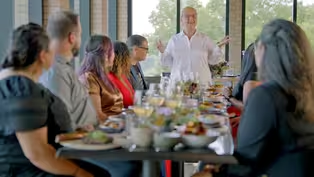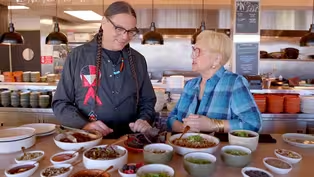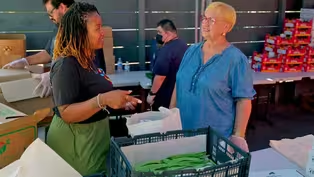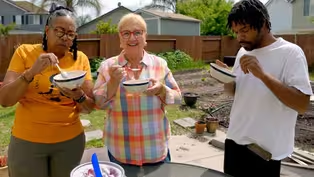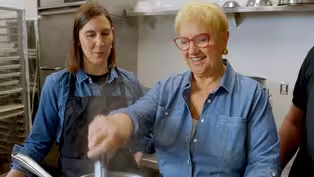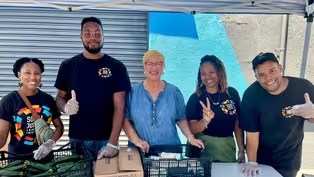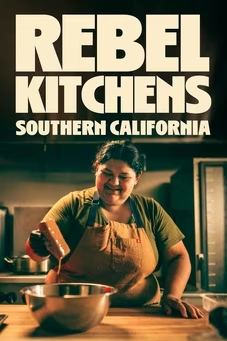Lidia Celebrates America
A Taste of Appalachia: Rabbit Food Reimagined
Clip: Season 2024 Episode 1 | 5m 25sVideo has Closed Captions
In Middletown, VA, Lidia teams up with chef Kari Rushing to elevate Appalachian cuisine's image.
In Middletown, VA, chef Kari Rushing is on a mission to change America’s perception of Appalachian cuisine. Her restaurant, Vault & Cellar, marries the resourcefulness of Appalachia – making do with what you have - with the refinement of fine dining. In the special, Lidia helps Kari prepare cabbage steak and “rabbit food,” incorporating rabbit, braised greens and roasted carrots.
Problems playing video? | Closed Captioning Feedback
Problems playing video? | Closed Captioning Feedback
Funding for LIDIA CELEBRATES AMERICA is provided by the Corporation for Public Broadcasting.
Lidia Celebrates America
A Taste of Appalachia: Rabbit Food Reimagined
Clip: Season 2024 Episode 1 | 5m 25sVideo has Closed Captions
In Middletown, VA, chef Kari Rushing is on a mission to change America’s perception of Appalachian cuisine. Her restaurant, Vault & Cellar, marries the resourcefulness of Appalachia – making do with what you have - with the refinement of fine dining. In the special, Lidia helps Kari prepare cabbage steak and “rabbit food,” incorporating rabbit, braised greens and roasted carrots.
Problems playing video? | Closed Captioning Feedback
How to Watch Lidia Celebrates America
Lidia Celebrates America is available to stream on pbs.org and the free PBS App, available on iPhone, Apple TV, Android TV, Android smartphones, Amazon Fire TV, Amazon Fire Tablet, Roku, Samsung Smart TV, and Vizio.
Buy Now
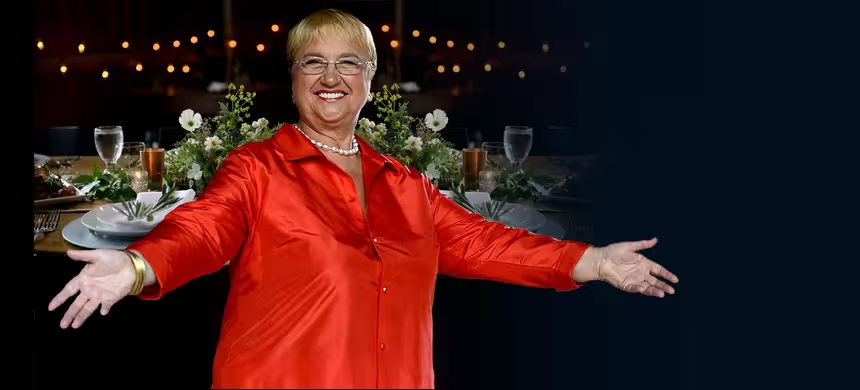
25 Years with Lidia: A Culinary Jubilee
Roll back the years and take an intimate look at the trajectory of Lidia's life both on and off the screen. Delve into her inspiring journey with engaging videos, and meet the remarkable woman whose legacy continues to shine.Providing Support for PBS.org
Learn Moreabout PBS online sponsorship- Kari, I'm in your kitchen.
Thank you for having me.
- Thanks for coming.
- I joined her in the kitchen to make a dish she calls rabbit food.
- It's kind of our signature dish here, and the accompaniments that go with it sort of started as an inside joke, 'cause we thought, "Okay, well what do rabbits eat?"
They eat greens, so we have some braised greens with it.
They eat carrots.
Everybody knows rabbits love carrots, so we have roasted carrots with it.
And we call it rabbit food.
- [Lidia] I love rabbit.
(Kari chuckles) I grew up with rabbits, I used to feed them.
How do you make it?
- So, first we have actually brined it, just a quick salt and pepper to let it sit overnight.
We're gonna use all this thyme, and some bay leaves, and lots of peppercorns, and some garlic.
And then we're gonna grab this oil back here, and just cover them.
And then we're gonna confit them nice and slow at 250 for about three hours.
(gentle music) So we're gonna make cabbage steak.
So you have this really nice, hearty, knife and fork sort of situation, and we're gonna make sort of a sweet and sour agrodolce.
- [Lidia] Alright.
Show me how.
- Yeah, of course.
We're just gonna oil, salt and pepper these, and then throw them on the flat top to sear.
- [Lidia] Okay.
- Every family around here has had cabbage steak for dinner because, (laughing) if you have a garden, you probably have cabbage in it.
- That's gonna get a nice caramelization on each side.
- So yeah, we're gonna make sure it gets a, a nice sear on both sides.
And then we'll cover it and hit it with some water to steam the insides of it.
It's maybe not the most special vegetable to a lot of people, but it can withstand the temperatures here, which flex terribly.
(Kari laughs) And it holds well, and it holds storage like in root fillers.
(gentle music) And then this is our confit leg out of the confit.
We're just warming this back up in here.
And just a reflection of those same flavors that were in the confit.
We're gonna throw a little more thyme in.
Minced garlic.
Our roasted carrots are going in the oven.
(gentle music) (food sizzling) See how we're doing.
Oh yeah.
When I think about a lot of world cuisines and specifically like, you know, French or Italian food, the things that we think of for the nice high-end celebration dinners, I've always wondered why the food that I grew up with couldn't be that.
- [Lidia] In Italy, we make plenty of agrodolce.
It's a question of sweet and sour.
- [Carrie] Yeah.
Just kind of drape it across the bottom of the cabbage, and then you can pull as much into each bite as you like.
- You know what I saw in Kari?
I saw pride in elevating that simple local food.
Why can't it be like French food?
Why can't it be like Italian food?
And that's the pride that each chef takes with the understanding of the flavors of the region, the products of the region.
They wanna highlight their own little world.
You know, I took a look at your menu, and I saw all kinds of good things.
Hunting, fishing, foraging.
That's wonderful.
This is really being connected to the environment and seasonality.
- So we're getting some nice brown butter action.
You don't need a lot of space to grow a garden, or, you know, raise rabbits, or have a worm bin for composting.
All of these things just to make your lives a little more environmentally friendly.
But I definitely think the pandemic played a huge role in getting people back to being concerned about where their food comes from and how it's handled, and just finding a deeper connection to their food.
(food sizzling) - And I think as a chef it's just, exalt those natural flavors, and you've got it.
That's your philosophy, right?
- Absolutely.
We've got our sauteed greens going down, a little of those pan juices.
- You have to use the knowledge, collaborate with the earth, with the people, and go back to the resources.
What I do, I have a recollection of a lot of the flavors from my grandmother or whatever.
And when I go to a stove, I reconstruct those flavors.
And I saw that Kari was doing that with a certain elegance, and with lots of pride.
- I'm waiting.
- Alright.
Here's the cabbage.
- [Lidia] This is like a Picasso.
- [Kari] (laughs) Thank you.
- Look at those colors.
How should we start?
What would you say?
- [Kari] I'll let you take the lead.
- I'm gonna have a little bit of cabbage first.
Okay.
And a little piece of rabbit.
So let's taste.
(gentle music) Mm.
Really delicious.
- People seem to think that this food isn't maybe worth elevation, but you absolutely can.
It's about the love, and the labor that goes into it.
And you know, it's, it's completely worth pulling out the fine China for.
A Feast for Change: The Celebration at Owamni
Video has Closed Captions
Clip: S2024 Ep1 | 3m 55s | The Changemakers from Lidia’s special unite at Sean Sherman’s Owamni for a celebratory meal. (3m 55s)
The Indigenous Cuisine of a James Beard Chef
Video has Closed Captions
Clip: S2024 Ep1 | 3m 40s | Lidia meets James Beard winner Sean Sherman to sample the fare at his upscale restaurant, Owamni. (3m 40s)
The Power of Produce: A Recipe for Healthy Eating
Video has Closed Captions
Clip: S2024 Ep1 | 4m 31s | Meet Nicole Steele, dedicated to providing healthy food access through free produce delivery (4m 31s)
Sweet Harvest: Strawberry Ice-cream with Local Flavor
Video has Closed Captions
Clip: S2024 Ep1 | 2m 34s | In Stockton, CA, Lidia makes homemade ice-cream with strawberries straight from the hothouse. (2m 34s)
Video has Closed Captions
Clip: S2024 Ep1 | 4m 32s | Lidia visits the 3 Cricketeers' test kitchen to taste-test pasta made with cricket powder and pesto. (4m 32s)
Video has Closed Captions
Preview: S2024 Ep1 | 1m 2s | Lidia Bastianich meets changemakers intent on re-shaping the future of food in America. (1m 2s)
Providing Support for PBS.org
Learn Moreabout PBS online sponsorshipSupport for PBS provided by:
Funding for LIDIA CELEBRATES AMERICA is provided by the Corporation for Public Broadcasting.
